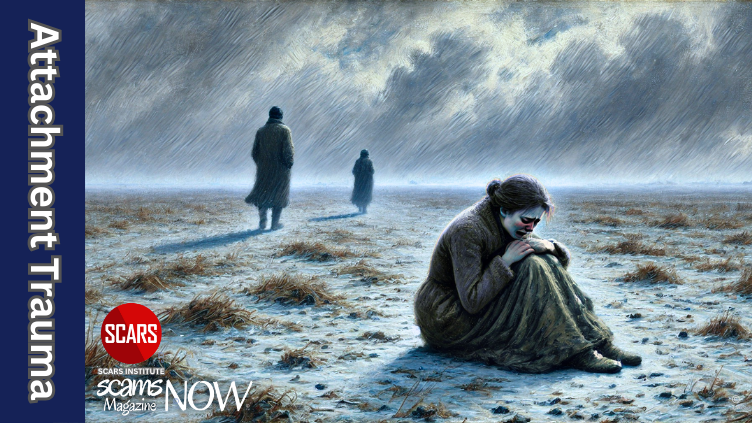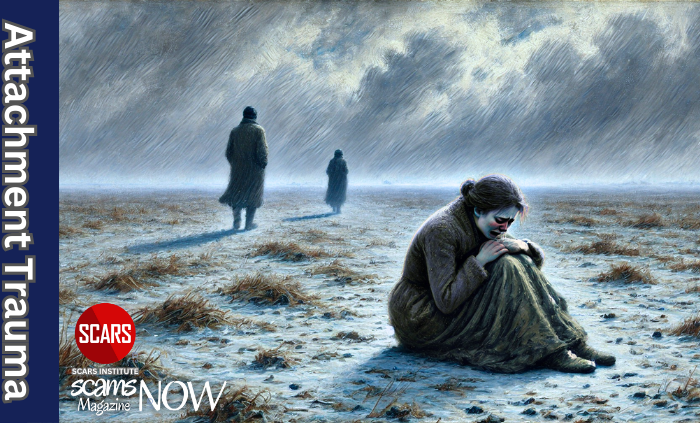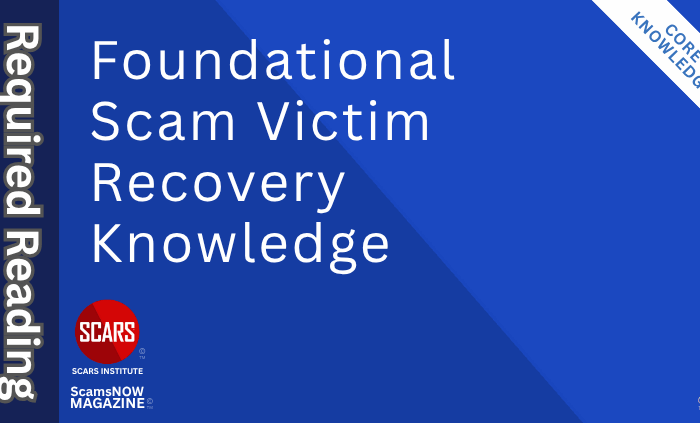
Episodism in Scam Victim Recovery
Episodic Recovery After Betrayal Trauma: Before, During, and After
Primary Category: Scam Victim Recovery Philosophy
Authors:
• Tim McGuinness, Ph.D., DFin, MCPO, MAnth – Anthropologist, Scientist, Polymath, Director of the Society of Citizens Against Relationship Scams Inc.
Author Biographies Below
About This Article
Episodism is an episodic view of betrayal trauma recovery that organizes life into “before,” “during,” and “after” without forcing a single, fixed story. By treating each phase as a contained chapter, a survivor may protect energy, name what happened with clarity, and build routines that calm the body and mind. The model can reduce shame, improve memory processing, and support safer choices through simple scripts, gentle check-ins, and trusted witnesses. Risks remain if compartments become walls, so the article encourages bridges that connect episodes through values, relationships, and steady practices. Presence in the current day carries more weight than a perfect explanation, and dignity grows when autonomy, boundaries, and support stand together. With patient repetition, small skills, and community, the after chapter may become livable, then hopeful, while honoring pain that still visits.
Note: This article is intended for informational purposes and does not replace professional medical advice. If you are experiencing distress, please consult a qualified mental health professional.

Episodism: Episodic Recovery After Betrayal Trauma: Before, During, and After
Author’s Note: We present this discussion of Episodism as yet another perspective on the scam victim/survivor’s experience from a different philosophical lens. There are a vast number of views or facets of this experience, and we strive to present as many as possible since not everyone can relate to all or even most of them. We hope this perspective will provide new insights into your experience.
What is Episodism?
Episodism, in contemporary philosophy of self, describes the view that some people experience themselves mainly in short, discrete stretches of time rather than as a single story stretching across years. On this view, a person may remember past events and plan ahead, yet feel little psychological pull to weave those events into a continuous life narrative. Galen Strawson popularized this contrast by distinguishing “Episodic” from “Diachronic” self-experience, and he argued that living well, acting responsibly, and having a stable identity do not require a narrative outlook.
Strawson developed the position in his essay Against Narrativity and related work, where he questioned the idea that everyone either does or should understand a life as a coherent story. Later commentators describe “temporal temperaments” along a spectrum, with episodic and diachronic styles both viable, and neither ethically superior.
Episodism here is distinct from “episodic memory” in cognitive science, which concerns memory for specific events. The philosophical use concerns how the self is felt to persist through time, not the mechanisms of memory.
An example of episodism is about the COVID Pandemic. Most of us tend to view our lives before, during, and after as separate episodes with their own distinct character and quality.
Episodic Recovery
After a relationship scam, life may feel divided into clear blocks of time, each with its own weather, sounds, and rules; this is the foundation of Episodism. The mind often marks a boundary around what came before the scam, what happened during it, and what remains after it ended. That boundary can be sharp, like a door that closes, or softer, like a curtain that drifts but still separates rooms. Seeing experience as a series of episodes can bring relief because each part appears easier to hold. It can also hide pain if the doors stay locked too long. Understanding how an episodic view works may help recovery proceed with less confusion and with more care for what still hurts.
Episodism in Everyday Terms
In everyday life, some people sense themselves most strongly in short stretches of time, not as one long story. The present moment carries more weight than a life narrative that ties past and future together. This style, often described with the label “episodic.” It is not a flaw. It is simply a way the mind organizes attention and emotion. Others feel themselves through continuity and story, a style often called “diachronic.” Many people move along a spectrum between these two styles across a lifetime. Stress, grief, and betrayal can push anyone toward a more episodic mode because the nervous system focuses on immediate safety and short horizons.
After a scam, episodism often shows up without being named. Thoughts return to what happened yesterday, or to the text that arrived last week, or to the call that still echoes. Planning may shrink to a day or a week. Remembering the past may feel heavy or unreliable. The desire to explain everything may fall away, and it may feel easier to live in smaller pieces that can be held without spilling. This narrowing often protects energy when emotion runs high.
Before the Scam, the First Episode
The period before the scam often appears brighter or simpler in hindsight. That does not mean it lacked stress or struggle. It means that trust felt less risky. Messages from new people did not tighten the chest. A request for help did not automatically ring alarms. The rhythm of life included effort and worry, yet the sense of basic safety felt stronger. In episodic terms, the before period is the first episode, closed and complete, with a different set of assumptions about people and risk.
Memory of this episode may carry grief, since it holds a version of the self that felt more open. Grief often brings mixed thoughts. One thought says that innocence was lost, and another says that strength grew. Both can be true. The mind may return to scenes from the before period in order to measure change. That measurement can hurt, yet it also clarifies what still matters. Values that stood before the scam often still stand after it. Honesty, kindness, curiosity, responsibility, and care for loved ones do not vanish because a criminal lied. Remembering this helps anchor identity when the new episode feels strange.
During the Scam, the Immersion Episode
The scam episode often feels like being submerged. The nervous system scans for signals from the other person, the phone, or the feed, and life narrows to the story being presented. This is not a sign of weakness. It is how influence works when a skilled manipulator learns a target’s hopes and fears. Scripts, staged photos, and rehearsed lines create a path that pulls attention forward step by step. That path may include intense affection, shared plans, quiet threats, or sudden crises that require fast action. Each step makes the previous step feel reasonable. That is how a maze works from the inside.
In this episode, memory may fragment. Details that felt clear in the moment become slippery after the fact. The body records the stress, even when the mind tries to calm it. Sleep may shorten, appetite may change, and judgment may bend toward the person who keeps asking for trust. Shame often grows here, which is part of why silence grows later. None of this means the target lacked intelligence or moral sense. It means the scammer’s design worked, and that design often uses rushed timing, isolation, and false authority to tilt the floor.
After the Scam, the Sequel No One Wanted
When the truth breaks through, the after episode begins. For many people, that break arrives in an instant, like a sudden light. For others, it arrives in small signals that accumulate until denial can no longer hold. The after period often brings anger, sadness, and a long wave of questions. It may also bring relief, since confusion ends and energy can move toward healing. Life starts to reorganize around new information. The mind looks for explanations that preserve dignity and restore control.
Episodism shows up strongly in this period. The desire to seal the prior episode and to live only from today can be strong. That desire can help for a while. Containment lowers emotional noise and allows the nervous system to settle. The presence of clear edges makes the world feel manageable again. Over time, though, some connection between the episodes may be needed to restore a sense of continuity, because continuity often supports confidence.
How an Episodic View Can Help
An episodic view can reduce overwhelm. When experience is held as three distinct periods, the brain has less to juggle at once. Before the scam holds what was true and valuable then. During the scam holds the events, choices, and pressures that occurred in that closed space. After the scam holds the present work, the current boundaries, and the next small steps. This separation can allow focused attention without forcing a single grand story to make sense immediately.
Clarity often improves when each period receives its own language. The before period may be described through values and routines. The during period may be described through facts, dates, and quotes from messages, which can keep memory organized and reduce self-blame. The after period may be described through feelings, needs, and plans that remain flexible. The mind can move among these boxes without dumping everything onto the same table.
An episodic view can also soften judgment. Many survivors feel pressure to explain why they did not see the signs. The question assumes a perfect continuous self who knows the end of the story while living the middle. Episodes do not work that way. In the during period, information is partial, and emotion is strong. In the after period, information is fuller, and emotion shifts. Allowing those differences to exist reduces harsh moral math that punishes the self for not knowing the future.
Containment supports safety. When the after period is set apart, a person may create calm routines that signal closure for the day, such as turning off notifications, choosing quiet media, or focusing on tasks that keep hands busy and thoughts grounded. These routines can mark the edge of the after episode each evening, which teaches the body that hard feelings have a boundary. Boundaries help the mind recover the sense that time, and not only emotion, is in charge.
Where an Episodic View Can Hurt
An episodic view can also hide pain if it becomes rigid. The before episode can turn into a golden past that no one can meet now, not even the person who remembers it. The during episode can turn into a sealed room that no one can open, which keeps trauma from processing. The after episode can turn into an endless present where hope struggles because the future stays too small. These risks do not mean the episodic style is wrong. They mean the style may need balance.
Avoidance is one risk. If the during episode is never visited, even briefly, intrusive memories may force their way in. Small, planned visits to that room, guided by a professional or a trusted support, can allow the mind to file what it needs to file. Denial is another risk. If the after episode insists that everything is fine when the body says otherwise, symptoms may grow, then surprise everyone later. A flexible episodic view allows movement among rooms when needed, without camping inside the hardest one longer than is helpful.
Isolation is a third risk. Episodes can become private territories that no one else may enter. Privacy protects dignity, yet complete isolation often feeds shame. Measured, boundaried conversation with one safe person can bring outside air into the rooms without turning them into public museums. That air helps memory settle, and it helps the nervous system learn that the present now includes allies.
When Episodism Turns Into Denial and Avoidance
When an episodic view hardens, the mind may try to weld the “during” and “after” rooms shut. The goal feels like safety, yet the seal often traps unprocessed fear, shame, and grief. Triggers then leak through in flashes, dreams, or sudden spikes of alarm, and daily life begins to organize around avoiding reminders rather than restoring confidence.
Language offers early clues. Phrases such as “that was not me” or “it never happened” may bring short relief, yet they also disconnect memory from meaning. Over time, the split can widen, and the “before” self becomes idealized while the present self carries blame. The gap invites perfectionism, silence, and isolation, which slows healing and keeps shame in charge.
Avoidance can look productive at first. Long workdays, constant errands, or endless scrolling may keep feelings out of view. The body still keeps score, and tension, sleep problems, and irritability often grow. Relationships feel fragile because simple questions sound like threats, and ordinary plans feel risky. A life built on dodging reminders rarely feels steady for long.
Denial sometimes rides along with hope. The promise that everything will return to the exact “before” can postpone helpful steps in the present. Hope serves recovery when it invites small actions, clear limits, and honest support. Hope turns into denial when it insists on a perfect reset, rejects aid, and refuses any story that includes harm and repair side by side.
Sealed rooms also block learning. The brain integrates when events can be named in simple terms, linked to values, and placed in time. When the door stays shut, memory remains scattered, and the same traps feel new each time. Gentle contact with the truth, done in short, contained moments, may reduce surprise and restore choice.
A rigid episodic wall can turn support into danger signals. Care from family, peer groups, or professionals may feel like interrogation, which invites retreat. Clear boundaries can ease this tension. Short conversations, time-limited check-ins, and one trusted witness may create enough safety for a little truth to be spoken without overwhelm.
Practical signs suggest that episodism is slipping into denial. If reminders always bring a full stop, if every conversation avoids the topic, or if private rituals turn into strict rules that never allow change, avoidance may be steering. Noticing these patterns can open space for small adjustments. A single sentence in a notebook, a brief acknowledgment to a safe person, or a quiet reflection at day’s end may loosen the seal without tearing it open.
An episodic frame still holds value when the rooms stay connected. The “before” can teach what mattered, the “during” can teach how pressure works, and the “after” can teach how steady practices rebuild. Bridges may include short scripts, simple gratitude lines, and present-day plans that match values. Each bridge keeps identity intact while allowing the hard parts to sit in daylight.
Denial and avoidance make sense when pain feels larger than words. They do not have to remain the only options. With patient pacing, kind language, and consistent support, the episodic view can stay flexible. Episodes then work as containers that protect energy, not as vaults that imprison it, and recovery may feel possible without pretending the harm never happened.
How Episodes Interact With Identity
Identity often feels dislocated after a scam. Many people ask whether they are the same person. The answer can be yes, and it can also be complicated. An episodic view allows identity to carry different weights in different rooms. In the before episode, identity may rest in values, friendships, and practices that still matter. In the during episode, identity may feel suspended or distorted because manipulation was strong. In the after episode, identity may return to values with added resolve, and it may include new boundaries that honor what was learned.
This approach protects self-respect. The person who cared for family, worked hard, and told the truth did not vanish. That person met a skilled deceiver who built a world and invited entry. The entry does not erase worth. The exit does not require permanent suspicion of all human contact. What it may require is a clearer sense of how trust is offered and how it is earned over time. A person can remain kind and become more discerning. Those traits can live together without canceling each other.
Bridging Episodes Without Forcing a Single Story
At some point, many survivors want more continuity. Not a single sweeping tale that smooths every rough edge, yet a simple thread that ties the rooms together. Threads can be small. A value that never changed can serve. A promise that survived can serve. A role, such as grandparent or neighbor or colleague, that remained steady can serve. Even a routine, such as morning coffee while reading, can appear in every episode and quietly announce, this is still a life.
Language can help bridge. Phrases that acknowledge both difference and continuity work well. Sentences that begin with words like now and still often carry the right weight. Now, fear rises and falls, and sleep improves in small steps. Still, honesty remains non-negotiable, and care for loved ones keeps its place at the center. These statements do not demand a perfect arc. They name a path, which is more realistic.
How Episodism Meets Memory and Emotion
Memory often changes shape after betrayal. Details may return at odd times, and the mind may argue with itself about what happened. An episodic view allows memory to be sorted by period, which reduces internal fights. If an image appears from the during episode, it belongs to that room, and it can be placed on that shelf, not on the shelf reserved for the present. If a detail from the before episode arrives, it can be honored without pretending that it is still the current rule.
Emotion often needs the same sorting. Anger belongs somewhere. It often belongs in the during episode, since it answers deception and harm. Sadness belongs somewhere. It often belongs in both the before and after episodes, since it answers what was lost and what must be rebuilt. Relief belongs somewhere. It often belongs to the after period, since the story is no longer being written by a criminal. Sorting does not reduce feeling. It gives each feeling a place, which keeps the present from being overwhelmed.
Relationships Across Episodes
Relationships can strain after a scam. Trust may feel thin. The episodic lens can help here, because it encourages simple conversations about which stories belong in which room. A partner may hear that some parts are not ready for open discussion, and that other parts are shareable. A friend may learn that the present includes normal days, not only crisis. A counselor may help mark a schedule for what room is visited when, so therapy has a rhythm that feels safe.
Support remains most helpful when it respects autonomy. Many survivors worry that help will come with control. Clear agreements ease this fear. A loved one may offer to listen for twenty minutes and then change the subject. A colleague may offer company for a walk without asking questions. A support group may invite one sentence during a meeting and welcome silence otherwise. Each offer assumes capability and choice, which protects dignity.
When an Episodic Style Feels Like Home
Some survivors find that the episodic style fits not only during recovery, but also beyond it. Living well does not require a single life story. It requires care for self and others, informed choices, and attention to what matters. If a shorter time horizon brings calm and competence, that may be the right style. If a longer narrative gradually returns, that may be right too. The aim is not to pass a test of storytelling. The aim is to live with integrity and steadiness.
Hope fits both styles. Hope can live in a small room that holds today’s tasks and the next call with someone trustworthy. Hope can also live in a longer corridor that stretches to seasons and years. Either way, the measure of recovery is not whether the old story is restored. The measure is whether life feels livable, with meaning, connection, and self-respect.
Practical Ways to Work With Episodes, Without Pressure
Gentle tools can support this view. Some survivors keep a notebook or journal with three sections labeled before, during, and after. Short entries go where they belong, which reduces clutter in the mind. Others use a simple calendar to mark nights with better sleep, or moments of joy, or boundaries kept. These marks show change without forcing grand conclusions. A therapist may guide brief, contained visits to the during episode to process a memory, then bring attention back to the present so the day can finish calmly.
Language helps here as well. Short scripts protect energy. Phrases like I am not ready to talk about that part or I can share a little, and then I need a break set limits while keeping connection open. In professional settings, phrases like I need a moment or I will answer next week create time to think. Boundaries like these keep the after episode from being pulled back into the middle of the story without consent.
When the Episodic Frame Needs Adjustment
Sometimes the episodic approach needs tuning. Signs include repeated intrusive memories that feel stronger over time, not weaker, or a sense that daily life has no forward motion. In those cases, a more connected view may help, because it invites meaning across episodes. Group support often helps here, since hearing others place their episodes in context can spark a similar shift. A therapist trained in trauma and dissociation may also help the nervous system learn that the present is safe enough to tolerate longer arcs.
Adjustment does not require abandoning the episodic style. It often requires adding a thin thread of continuity, like a value or a role that remains steady. It may also require adding moments that look ahead, not only back. Planning a small future event, such as a visit with a friend or a hobby class, can open the window a little wider. The goal is not to force optimism. The goal is to invite a little more sky into the room.
Why Compassion Matters at Every Stage
Compassion supports healing in every episode. Harsh self-talk inflames fear, narrows attention, and keeps shame active. Kind language calms the body, opens attention, and allows learning. Compassion does not excuse criminal harm. It reminds the survivor that worth remains intact and that skill grows with time. People who receive compassion from others often find it easier to offer compassion to themselves, which then makes boundaries easier to hold.
Communities that speak without blame make disclosure safer. Families that listen first and plan second often see better outcomes. Professionals who validate the reality of betrayal while affirming capacity reduce the fear of being labeled or controlled. Each compassionate act rebuilds trust in human contact, which is a central task in the after episode.
A Way to Think About the Road Ahead
Recovery is not a contest between styles of self. It is a human process that tolerates difference and change. For some, episodes will remain the most comfortable frame. For others, a broader story will gradually return. Both can support a good life. What matters most is the gentle attention brought to each day, the respect kept for the person who lived through harm, and the willingness to keep going, even when the road bends.
The before episode deserves gratitude for what it gave. The during episode deserves accurate naming and careful processing. The after episode deserves calm structure, kind company, and time. When these gifts are offered, identity can breathe again, and confidence can return in steady, quiet ways. A scam may mark a life, and it does not have to define it. The episodes can sit side by side on the same shelf, with the present holding the pen.
Conclusion
Across the three episodes of before, during, and after, recovery becomes less about restoring a single story and more about presence in the life you have now. An episodic view can protect energy, organize memory, and calm the nervous system during hard days. It can also harden into avoidance if rooms stay sealed, so gentle bridges that connect values, relationships, and routines may help. With small scripts, simple check-ins, and a trusted witness, you can hold what hurts without letting it run your day.
Compassion remains the anchor. When language stays kind, shame eases, and learning returns. Boundaries that fit your needs keep dignity intact while contact with safe people reaffirms belonging. Whether continuity grows again or short horizons continue to feel right, your worth does not depend on a perfect narrative. It rests in honest effort, careful choices, and the meanings you keep.
As time moves, the episodes can sit side by side, with the present giving them shape and limits. You may grieve what was lost, and you may notice strength that did not exist before. With patience, practice, and company, the after episode becomes livable, then hopeful, and the road ahead makes space for pain and possibility.

Glossary
- After episode — Refers to the period that begins when the scam is exposed or ends. A survivor may feel anger, relief, grief, and disorientation while building new routines that restore safety and confidence. Clear structure, gentle pacing, and one trusted witness often help this chapter settle.
- Avoidance — Describes efforts to stay away from reminders of the scam, the scammer, or painful feelings. Short breaks can reduce overwhelm, yet long-term avoidance tends to keep fear, shame, and confusion in place. Planned, time-limited contact with the truth often supports steadier recovery.
- Boundaries — Means clear limits on topics, time, money, and access that protect dignity and energy. A survivor may set limits on questions, calls, and social media, and may choose who hears which part of the story. Consistent boundaries reduce pressure and make cooperation easier.
- Bridge sentence — A short line that connects episodes without forcing a single story. Examples include, “Now, sleep improves in small steps; still, honesty remains my guide.” Bridge sentences reduce all-or-nothing thinking, and they help identity feel continuous.
- Calm routine — A simple sequence that signals safety to body and mind. Examples include slow breathing, a brief walk, light chores, and a predictable bedtime. Repeating the same steps each evening teaches the nervous system that hard feelings have a stopping point.
- Compassionate language — Words that describe harm accurately while respecting the person who lived through it. Phrases like “a criminal deceived her” shift attention from self-blame to accountability. Kind language lowers shame, and learning returns more easily.
- Containment — A way to hold painful material in a defined space or time so it does not spill into the whole day. This may include a set therapy hour, a few notebook lines, or a short conversation with a trusted person. Containment protects energy while processing continues.
- Continuity — The sense that identity remains recognizable across change. Continuity can rest on values, relationships, and daily roles rather than on perfect memory or unbroken confidence. Naming what remains steady helps counter the feeling of being a different person.
- Denial — A refusal to recognize the reality or impact of the scam, often as a short-term shield. Denial may feel safer, yet it tends to prolong confusion and isolate the survivor. Gentle facts, kind tone, and small disclosures can open space for recognition without collapse.
- Diachronic self — A style of self-experience that feels like one story stretching over time. People with a diachronic style may link past, present, and future with ease. Knowing this term helps families respect that others may prefer an episodic style instead.
- Disclosure — The act of sharing selected facts or feelings with a specific person. Measured disclosure, planned in advance, often reduces shame and brings practical support. A survivor stays in charge by choosing what to say, to whom, and when to stop.
- Dissociation — A stress response that creates distance from thoughts, feelings, or surroundings. It may feel like going blank, losing time, or watching oneself from the outside. Awareness of dissociation helps a survivor add grounding steps and pace conversations.
- Dual awareness — The skill of holding two truths at once, such as “harm happened” and “the present is safer.” This skill allows processing without flooding. Simple cues, like naming three things in the room, can anchor attention in the present while feelings pass through.
- Emotional flashback — A sudden surge of fear, shame, or grief without a clear picture or memory. Ordinary cues, like a ringtone, may trigger old feelings. Naming the flashback and returning to grounding steps often lowers intensity.
- Episodic memory — Memory for specific events and moments. It differs from episodism, which concerns how a person experiences identity across time. Clear labeling prevents confusion and supports better conversations with helpers.
- Episodism — A style of self-experience that organizes life into shorter chapters, such as before, during, and after. This style can conserve energy, reduce overwhelm, and allow focused repair. It may need flexible bridges so episodes do not become sealed rooms.
- Family witness — A relative who listens without blame, keeps information private, and supports calm steps. One steady witness often makes disclosure safer and planning easier. Clear agreements about time, topics, and follow-up protect everyone involved.
- Grief work — The honest recognition of what was lost, including time, trust, plans, or imagined futures. Grief can come in waves and may sit beside relief and anger. Naming losses in plain words helps restore meaning and reduces hidden pressure.
- Grounding — Brief actions that bring attention back to the present. Examples include slow exhales, feeling both feet on the floor, or naming five things that can be seen. Grounding lowers arousal and makes conversations and decisions easier.
- Hope as fuel — A practical, action-ready form of hope that invites small steps rather than promises a perfect reset. It supports scripts, check-ins, and measured plans. Hope functions best when it accepts mixed emotions and allows steady pacing.
- Hypervigilance — A constant scan for danger that follows betrayal or threat. It may cause poor sleep, irritability, and difficulty trusting even kind people. Small routines, reliable boundaries, and one safe companion help reduce this strain over time.
- Identity anchor — A stable element that carries through all episodes, such as a value, a role, or a daily practice. Examples include honesty, grandparenting, or morning reading. Naming anchors helps identity feel intact during change.
- Intrusive memory — An unwanted image, sound, or thought that arrives without invitation. These memories can feel strong and may repeat. Brief labeling, calm breathing, and returning to a chosen task can reduce their grip.
- Isolation — Pulling away from contact to avoid shame, judgment, or reminders. Short solitude can restore energy, yet long isolation often feeds fear and false beliefs. One measured conversation a week with a trusted person can reopen the connection safely.
- Journal or notebook — A private place to record dates, phrases, body sensations, and small wins. Short entries help organize memory by episode and show progress over time. Written notes reduce mental clutter and support reporting or therapy when chosen.
- Kind pacing — A rate of change that respects attention, sleep, and daily life. It avoids all-at-once fixes and favors repeatable steps that build confidence. Kind pacing turns recovery into maintenance rather than an emergency.
- Memory sorting — Placing details in the episode they belong to: before, during, or after. Sorting reduces unfair self-judgment and keeps the present from carrying every feeling at once. A few lines per episode in a notebook often help.
- Micro-steps — Very small, repeatable actions that move recovery forward. Examples include one phone call returned, one boundary kept, or one paragraph written. Micro-steps create momentum without overwhelm.
- Narrative pressure — The urge to produce a single, neat story that explains everything. This pressure often increases shame and blocks disclosure. Allowing partial stories by episode reduces strain and keeps dignity intact.
- Present-focus practice — A gentle habit that keeps attention on today’s tasks and supports calm function. Examples include a short checklist, a set mealtime, and a brief walk after dinner. Present-focus makes life manageable when long planning feels hard.
- Privacy with connection — A balance where sensitive details stay private while one or two people remain in the loop. This approach protects dignity and prevents isolation. Clear agreements about topics and timing keep trust strong.
- Safety plan — A written set of steps to use during spikes of distress or contact attempts. Typical elements include two grounding actions, two people to call, and one exit line for unexpected conversations. Visible placement makes the plan easier to use.
- Shame spiral — A loop of self-blame thoughts that grows stronger with silence and isolation. Naming the spiral, stating accurate responsibility, and speaking to one safe person often break the loop. Kind language is essential here.
- Short-horizon planning — Setting goals for the next hour, day, or week when attention and energy are limited. This keeps progress visible and reduces pressure to “fix everything.” Small plans add up to meaningful change.
- Therapist trained in trauma and dissociation — A clinician who understands betrayal trauma responses and works at a steady, tolerable pace. This professional may guide brief visits to hard material, then return attention to the present. Training matters because it lowers risk of overwhelm.
- Trigger — A cue that brings back intense feelings or body reactions linked to the scam. Triggers can be sounds, dates, phrases, or images. Identifying common triggers allows better preparation and faster recovery when they appear.
- Trusted witness — A nonjudgmental person who can hear the story, reflect reality, and support next steps. The role centers on presence, privacy, and calm follow-through. One witness is often more helpful than many opinions.
- Values anchor — A core principle, such as honesty, care, or responsibility, that guides choices in every episode. Naming values helps decisions feel consistent and self-respect remain intact. Values turn identity into practice, not performance.
- Window of tolerance — The range in which a person can think, feel, and function without shutting down or becoming overwhelmed. Gentle routines and paced disclosures widen this window over time. Staying inside this range makes recovery steadier and safer.
Author Biographies
-/ 30 /-
What do you think about this?
Please share your thoughts in a comment below!
TABLE OF CONTENTS
- Episodic Recovery After Betrayal Trauma: Before, During, and After
- Episodism: Episodic Recovery After Betrayal Trauma: Before, During, and After
- What is Episodism?
- Episodic Recovery
- Episodism in Everyday Terms
- Before the Scam, the First Episode
- During the Scam, the Immersion Episode
- After the Scam, the Sequel No One Wanted
- How an Episodic View Can Help
- Where an Episodic View Can Hurt
- When Episodism Turns Into Denial and Avoidance
- How Episodes Interact With Identity
- Bridging Episodes Without Forcing a Single Story
- How Episodism Meets Memory and Emotion
- Relationships Across Episodes
- When an Episodic Style Feels Like Home
- Practical Ways to Work With Episodes, Without Pressure
- When the Episodic Frame Needs Adjustment
- Why Compassion Matters at Every Stage
- A Way to Think About the Road Ahead
- Conclusion
- Glossary
CATEGORIES
![NavyLogo@4x-81[1] Episodism in Scam Victim Recovery - 2025](https://scamsnow.com/wp-content/uploads/2025/04/NavyLogo@4x-811.png)
ARTICLE META
Important Information for New Scam Victims
- Please visit www.ScamVictimsSupport.org – a SCARS Website for New Scam Victims & Sextortion Victims.
- SCARS Institute now offers its free, safe, and private Scam Survivor’s Support Community at www.SCARScommunity.org – this is not on a social media platform, it is our own safe & secure platform created by the SCARS Institute especially for scam victims & survivors.
- SCARS Institute now offers a free recovery learning program at www.SCARSeducation.org.
- Please visit www.ScamPsychology.org – to more fully understand the psychological concepts involved in scams and scam victim recovery.
If you are looking for local trauma counselors, please visit counseling.AgainstScams.org
If you need to speak with someone now, you can dial 988 or find phone numbers for crisis hotlines all around the world here: www.opencounseling.com/suicide-hotlines
Statement About Victim Blaming
Some of our articles discuss various aspects of victims. This is both about better understanding victims (the science of victimology) and their behaviors and psychology. This helps us to educate victims/survivors about why these crimes happened and not to blame themselves, better develop recovery programs, and help victims avoid scams in the future. At times, this may sound like blaming the victim, but it does not blame scam victims; we are simply explaining the hows and whys of the experience victims have.
These articles, about the Psychology of Scams or Victim Psychology – meaning that all humans have psychological or cognitive characteristics in common that can either be exploited or work against us – help us all to understand the unique challenges victims face before, during, and after scams, fraud, or cybercrimes. These sometimes talk about some of the vulnerabilities the scammers exploit. Victims rarely have control of them or are even aware of them, until something like a scam happens, and then they can learn how their mind works and how to overcome these mechanisms.
Articles like these help victims and others understand these processes and how to help prevent them from being exploited again or to help them recover more easily by understanding their post-scam behaviors. Learn more about the Psychology of Scams at www.ScamPsychology.org
SCARS INSTITUTE RESOURCES:
If You Have Been Victimized By A Scam Or Cybercrime
♦ If you are a victim of scams, go to www.ScamVictimsSupport.org for real knowledge and help
♦ SCARS Institute now offers its free, safe, and private Scam Survivor’s Support Community at www.SCARScommunity.org/register – this is not on a social media platform, it is our own safe & secure platform created by the SCARS Institute especially for scam victims & survivors.
♦ Enroll in SCARS Scam Survivor’s School now at www.SCARSeducation.org
♦ To report criminals, visit https://reporting.AgainstScams.org – we will NEVER give your data to money recovery companies like some do!
♦ Follow us and find our podcasts, webinars, and helpful videos on YouTube: https://www.youtube.com/@RomancescamsNowcom
♦ Learn about the Psychology of Scams at www.ScamPsychology.org
♦ Dig deeper into the reality of scams, fraud, and cybercrime at www.ScamsNOW.com and www.RomanceScamsNOW.com
♦ Scam Survivor’s Stories: www.ScamSurvivorStories.org
♦ For Scam Victim Advocates visit www.ScamVictimsAdvocates.org
♦ See more scammer photos on www.ScammerPhotos.com
You can also find the SCARS Institute’s knowledge and information on Facebook, Instagram, X, LinkedIn, and TruthSocial
Psychology Disclaimer:
All articles about psychology and the human brain on this website are for information & education only
The information provided in this and other SCARS articles are intended for educational and self-help purposes only and should not be construed as a substitute for professional therapy or counseling.
Note about Mindfulness: Mindfulness practices have the potential to create psychological distress for some individuals. Please consult a mental health professional or experienced meditation instructor for guidance should you encounter difficulties.
While any self-help techniques outlined herein may be beneficial for scam victims seeking to recover from their experience and move towards recovery, it is important to consult with a qualified mental health professional before initiating any course of action. Each individual’s experience and needs are unique, and what works for one person may not be suitable for another.
Additionally, any approach may not be appropriate for individuals with certain pre-existing mental health conditions or trauma histories. It is advisable to seek guidance from a licensed therapist or counselor who can provide personalized support, guidance, and treatment tailored to your specific needs.
If you are experiencing significant distress or emotional difficulties related to a scam or other traumatic event, please consult your doctor or mental health provider for appropriate care and support.
Also read our SCARS Institute Statement about Professional Care for Scam Victims – click here
If you are in crisis, feeling desperate, or in despair, please call 988 or your local crisis hotline – international numbers here.
More ScamsNOW.com Articles
A Question of Trust
At the SCARS Institute, we invite you to do your own research on the topics we speak about and publish. Our team investigates the subject being discussed, especially when it comes to understanding the scam victims-survivors’ experience. You can do Google searches, but in many cases, you will have to wade through scientific papers and studies. However, remember that biases and perspectives matter and influence the outcome. Regardless, we encourage you to explore these topics as thoroughly as you can for your own awareness.
























![scars-institute[1] Episodism in Scam Victim Recovery - 2025](https://scamsnow.com/wp-content/uploads/2025/04/scars-institute1.png)
![niprc1.png1_-150×1501-1[1] Episodism in Scam Victim Recovery - 2025](https://scamsnow.com/wp-content/uploads/2025/04/niprc1.png1_-150x1501-11.webp)
